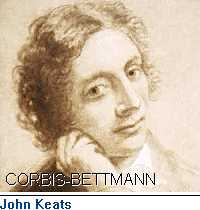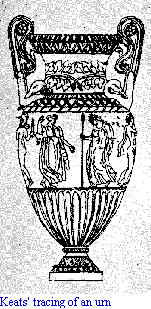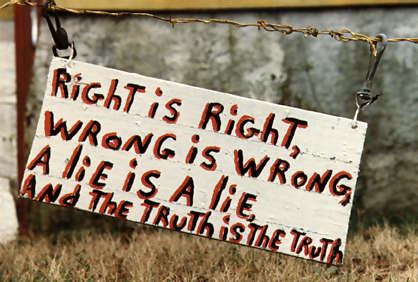Beauty Is Truth
What's this bit about "beauty is truth"? Is it true--or
is is just poetry?
 It's from a poem, "Ode On A Grecian Urn," written by John Keats in
May, 1819, when he was about 24. The urn is apparently decorated
with a picture of a youth playing a flute in a pastoral setting
and a young man chasing a young woman around the urn. She may well
wish him to catch her--but the important thing is that on the urn,
the music is silent and the chase, perpetual.
It's from a poem, "Ode On A Grecian Urn," written by John Keats in
May, 1819, when he was about 24. The urn is apparently decorated
with a picture of a youth playing a flute in a pastoral setting
and a young man chasing a young woman around the urn. She may well
wish him to catch her--but the important thing is that on the urn,
the music is silent and the chase, perpetual.
And of course, it's worth remembering here that the function
of an urn is to hold for eternity the ashes of the dead.
 The poem begins with some questions about the
figures pictured on the urn, then moves to this statement: "Heard melodies are sweet, but those unheard /
Are sweeter. . . . / Bold Lover, never, never canst thou kiss. .
. . / Forever wilt thou love and she be fair!"
The poem begins with some questions about the
figures pictured on the urn, then moves to this statement: "Heard melodies are sweet, but those unheard /
Are sweeter. . . . / Bold Lover, never, never canst thou kiss. .
. . / Forever wilt thou love and she be fair!"
The poem ends with these lines, apparently addressed to the urn
itself:
When old age
shall this generation waste,
Thou shalt remain, in midst of other woe
Than ours, a friend to man, to whom thou say'st,
"Beauty is truth, truth
beauty,"--that is all
Ye know on earth, and all ye need to know.
The words in question--"beauty is truth"--appear to be uttered by
the urn, as if it were some sort of oracle--or maybe in the way a
shell speaks for the sea when you hold it to your ear.
Unfortunately, the quotation marks appeared in the first
published edition, in 1820, but not in any of five other
reproductions of the poem made in that year. So no one seems to
know now whether the quoted words are spoken by the urn and the
rest by Keats or a persona, or whether the persona speaks all of
the words. Nor is there much agreement as to whether the lines
express a universal truth--or are just poetic blather.
Keats himself apparently never explained his intentions. He died
of tuberculosis in 1821, only about eight years after beginning
his career as a poet. The portrait below was made shortly before
he died.

Oh, one more thing: The predecessor to this web page is a
sheet of paper on my college office door bearing a picture of a
Grecian urn and the last two lines of Keats' poem--"'Beauty is truth, truth beauty,'--that is all
/ Ye know on earth, and all ye need to know."
There's also my own question, "Is this so--or is it just
poetry?"
I taped the paper to my door around 1990, after learning that
several of my English department colleagues had lied to destroy
another teacher's reputation and had falsified official college
records and perjured themselves in a lawsuit. Over the years
the paper has been on my door, a number of persons have added
their own comments, some ugly, some lovely. My favorite of
all is one where the contributor crossed out my word "poetry" and
wrote in "pottery." Terrific!
(You know, beauty is skin deep, but lovely comes from the
heart. How could it be other than true?)
Several other notable personages have made pronouncements about
truth and beauty. Here are a few I've found interesting or
amusing.
First, let's have a few equations that may be axiomatic:
|
Beauty |
= |
Truth |
|
Knowledge |
= |
Power |
|
Less |
= |
More |
|
God |
= |
Love |
|
The shortest distance between two points |
= |
a straight line |
|
And by
commutation:
Truth |
= |
Beauty
(yes???
if so, what about the others? are they reversible?) |
Next, a conundrum of sorts:
"The opposite of
a correct statement is a false statement. But the opposite
of a profound truth may well be another profound statement."
--Niels Bohr (Laurence J. Peter, Peter's
Quotations, New York: Bantam Books, Inc., 1977, 500.)
Compare that with this, which I heard in an episode of the PBS
biography of Robert Oppenheimer. (I'm not positive I've got it
verbatim, but pretty sure of the terms"shallow" and "deep." )
SHALLOW
TRUTH--has as its contrary that the opposite is false.
DEEP TRUTH--when true has
an opposite which may also at least in part be true.
Bohr and Oppenheimer were physicists. Their work was important in
developing the atomic bomb. :
Now for a few others' ideas:
"The truth is
more important than the facts."
--Frank Lloyd Wright (Laurence J. Peter, Peter's
Quotations,
New York: Bantam Books, Inc., 1977, 500.)
"Facts are the
enemy of truth."
--Spoken by Don Quixote, in the Broadway musical A
Man of La Mancha, by Dale Wasserman.
"I never give
them hell. I just give them the facts and they think it's
hell."
--Harry S Truman (Laurence J. Peter, Peter's
Quotations, New York: Bantam Books, Inc., 1977, 500.)
"When I am
working on a problem, I never think about beauty. I think
only how to solve the problem. But when I have finished, if
the solution is not beautiful, I know it is wrong."
--Buckminster Fuller (Laurence J. Peter, Peter's
Quotations,
New York: Bantam Books, Inc., 1977, 37.)
"Truth exists,
only falsehood has to be invented."
--Georges Braque, Penses sur l'Art.
"The truth is a
matter of perception."
--William Ginsburg (Monica Lewinsky's lawyer), TV
interview, May or June 1998.

--Joseph Light
(This photograph is one of a series of 8 photos belonging to Joel Slotnikov, of Blues World
Music.
Click on the photo to see the entire series. It will
open in a new window.
The "I" in the text beneath the photos is Slotnikov.)
I think Walt Whitman, who probably had the grandest vision of all
poets writing in English, should get the last word on this
subject.
All truths wait in all
things,
They neither hasten their own delivery nor resist it,
They do not need the obstetric forceps of the surgeon.
The insignificant is as big to me as any,
What is less or more than a touch?
Logic and sermons never convince,
The damp of the night drives deeper into my soul.
Only what proves itself to every man and woman is so,
Only what nobody denies is so.
--"Song of Myself," lines 647-655.
Ah, but wait. Emily Dickinson had a caution about how
to advise others of your truth:
Tell all the Truth but
tell it slant --
Success in Circuit
lies
Too bright for our
infirm Delight
The Truth's superb
surprise
As Lightning to
the Children eased
With explanation
kind
The Truth must
dazzle gradually
Or every man be
blind --
|
Other
Things
Index
Home page
Email me

(Sorry--SPAM. Please type it into the "To:" place in
an email message.)
 It's from a poem, "Ode On A Grecian Urn," written by John Keats in
May, 1819, when he was about 24. The urn is apparently decorated
with a picture of a youth playing a flute in a pastoral setting
and a young man chasing a young woman around the urn. She may well
wish him to catch her--but the important thing is that on the urn,
the music is silent and the chase, perpetual.
It's from a poem, "Ode On A Grecian Urn," written by John Keats in
May, 1819, when he was about 24. The urn is apparently decorated
with a picture of a youth playing a flute in a pastoral setting
and a young man chasing a young woman around the urn. She may well
wish him to catch her--but the important thing is that on the urn,
the music is silent and the chase, perpetual.  The poem begins with some questions about the
figures pictured on the urn, then moves to this statement: "Heard melodies are sweet, but those unheard /
Are sweeter. . . . / Bold Lover, never, never canst thou kiss. .
. . / Forever wilt thou love and she be fair!"
The poem begins with some questions about the
figures pictured on the urn, then moves to this statement: "Heard melodies are sweet, but those unheard /
Are sweeter. . . . / Bold Lover, never, never canst thou kiss. .
. . / Forever wilt thou love and she be fair!" 

